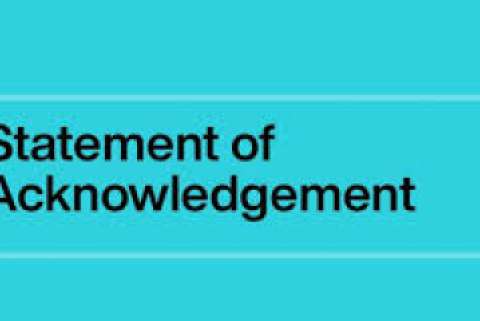Introduction
In the intricate tapestry of human interaction, acknowledgment statements serve as the threads that weave together understanding, empathy, and connection. These simple yet powerful expressions have the capacity to transform conversations, nurture relationships, and create an environment where every voice feels heard. In this article, we explore the significance of acknowledgment statements, their role in various contexts, and how mastering this art can enhance communication dynamics and foster a culture of empathy and respect.
Defining Acknowledgment Statements
At its core, an acknowledgment statement is a verbal or non-verbal response that validates and recognizes the thoughts, feelings, or contributions of others. It is an artful way of expressing understanding, appreciation, or empathy, creating a bridge between communicators.
Keyword Example: Acknowledgment Statements
The Power of Simple Recognition
In our daily interactions, the power of simple recognition cannot be overstated. Whether in personal relationships, professional settings, or casual conversations, acknowledgment statements act as a catalyst for positive communication, setting the tone for meaningful exchanges.
Keyword Example: Simple Recognition
Acknowledgment in Personal Relationships
In personal relationships, acknowledgment statements form the cornerstone of emotional connection. The ability to express understanding and appreciation strengthens the bond between individuals. Statements like "I hear you" or "I appreciate your perspective" convey a sense of validation that nurtures trust and intimacy.
Keyword Example: Emotional Connection
Acknowledgment in Professional Settings
In the workplace, acknowledgment statements play a pivotal role in fostering a positive and collaborative environment. Recognizing the efforts, ideas, and achievements of colleagues contributes to a culture of appreciation and motivates individuals to excel. It goes beyond mere politeness; it is an integral aspect of effective leadership and team dynamics.
Keyword Example: Workplace Environment
Navigating Challenging Conversations
Acknowledgment statements are particularly valuable in navigating challenging conversations. When faced with disagreements or conflicts, expressing understanding through statements like "I see where you're coming from" or "I acknowledge your concerns" opens the door to constructive dialogue. It sets the stage for resolution by validating diverse perspectives.
Keyword Example: Challenging Conversations
The Art of Non-Verbal Acknowledgment
While words are a powerful medium, non-verbal acknowledgment can be equally impactful. Non-verbal cues such as nods, smiles, and attentive body language convey active listening and understanding. In some instances, actions speak louder than words, and a simple gesture can convey volumes.
Keyword Example: Non-Verbal Acknowledgment
Cultivating Empathy through Acknowledgment
Acknowledgment is closely intertwined with empathy—the ability to understand and share the feelings of others. When acknowledgment statements are infused with genuine empathy, they become a bridge that connects individuals on a deeper level. Statements like "I can imagine how that must feel" or "Your perspective is important, and I value it" create an atmosphere of mutual understanding.
Keyword Example: Cultivating Empathy
Mastering the Art of Acknowledgment Statements
Active Listening Skills
The foundation of effective acknowledgment lies in active listening. Cultivate the art of truly hearing and understanding what others are saying. Responding with statements that reflect your engagement, such as "I hear you" or "Go on, I'm listening," demonstrates your commitment to being fully present.
Keyword Example: Active Listening
Verbal Affirmations
Verbal affirmations are key components of acknowledgment statements. Phrases like "I appreciate your input" or "Thank you for sharing your perspective" convey recognition and gratitude. These affirmations validate the speaker's contribution to the conversation.
Keyword Example: Verbal Affirmations
Expressing Understanding
Explicitly expressing understanding is a central aspect of acknowledgment. Statements like "I understand where you're coming from" or "I see your point of view" communicate that you are attuned to the speaker's thoughts or feelings.
Keyword Example: Expressing Understanding
Using "I" Statements
Utilize "I" statements to convey your perspective and feelings. For example, saying "I acknowledge the effort you put into this project" or "I value your opinion on this matter" takes ownership of your acknowledgment, making it more personal and sincere.
Keyword Example: "I" Statements
Real-World Scenarios of Effective Acknowledgment
Customer Service Excellence
In customer service, acknowledgment statements are fundamental. Responding to customer inquiries with statements like "I understand your concern, and we are here to assist you" demonstrates empathy and assures customers that their needs are acknowledged and valued.
Keyword Example: Customer Service Excellence
Conflict Resolution in the Workplace
In the workplace, acknowledgment plays a vital role in conflict resolution. Acknowledging the perspectives of conflicting parties with statements like "I recognize that there are differing opinions, and let's find a resolution together" establishes a foundation for collaborative problem-solving.
Keyword Example: Conflict Resolution
Cultivating a Culture of Acknowledgment
Beyond individual mastery, cultivating a culture of acknowledgment within a group, organization, or community is a collective effort. Encourage open communication, provide training on active listening skills, and celebrate instances of effective acknowledgment to reinforce its importance.
Keyword Example: Culture of Acknowledgment
A culture that values acknowledgment contributes to a positive and supportive atmosphere where individuals feel seen, heard, and appreciated.
Conclusion
Elevating Communication through Acknowledgment
In conclusion, acknowledgment statements serve as the threads that weave through the fabric of communication, binding individuals in a tapestry of understanding and respect. Mastering the art of acknowledgment requires intention, active listening, and a genuine commitment to validating the experiences of others.
Keyword Example: Conclusion
As we navigate the complexities of human interaction, let us embrace acknowledgment as a guiding principle—an ever-present beacon that lights the way toward richer connections, deeper understanding, and a world where every voice is acknowledged and valued.



